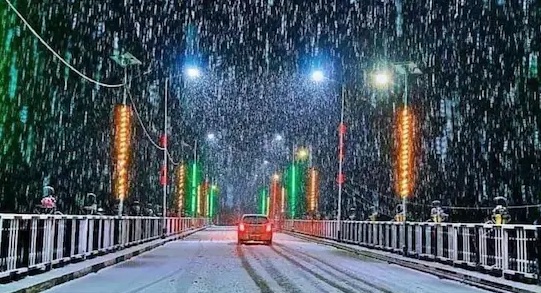The winter this time has been particularly severe, with night temperatures having plummeted to -8.5 degrees Celsius in Srinagar and -13°C in the tourist resort of Gulmarg.
While tourists and locals welcomed the first snowfall in several years during Chillai Kalan – the harshest 40 days of winter starting December 21 – in Kashmir, the cold wave also left a trail of misery, with frozen pipes, cold nights and sunless days.
It also led to tragedy. On Sunday, Gingle village in Uri buried five members of a family, a couple and their three children, who died of suffocation at their rented house while using a gas heater to keep warm.
The winter this time has been particularly severe, with night temperatures having plummeted to -8.5 degrees Celsius in Srinagar and -13°C in the tourist resort of Gulmarg. In south Kashmir’s Shopian, night temperatures have hovered around -10° for several days.
“It is after a long time that I’m seeing our taps and water pipes frozen,” said Irshad Ahmad, a resident of Shalteng, Srinagar. “I remember in the old days, our iron water pipes would freeze and we would spend days unclogging them using the flame stove. But these days, the iron pipes are replaced by the PPR (Polypropylene Random Copolymer) water pipes and they can’t even be heated. We had a tough time getting these frozen pipes unclogged. One can live with the cold, but not without water,” he said.
Sub-zero temperatures in the Valley during winter are not uncommon, but this time, night temperatures have gone a few notches below normal. The -8.5°C night temperature recorded in Srinagar on December 21 was the lowest in close to a century. It was in 1934 that Srinagar recorded a lower night temperature at -12.8°C.
“We have seen below normal temperatures in the plains of the Valley this year,” independent weather forecaster Faizan Ahmad told . “But in the higher reaches like Gulmarg, we have observed that the temperatures have hovered around normal or above normal,” he said.
Over the last few decades, traditional Kashmiri houses, which were designed to help residents withstand the bitter cold and were plastered with mud and sported small windows, have been replaced with concrete structures that provide little insulation.
The hamam, a room with traditional underfloor heating that had previously been common only in mosques, is now becoming an essential part of new Kashmiri houses. Some are even renovating their old houses to make space for a hamam.
The affluent have also been relying on electric under-floor heating systems to keep rooms warm. However, unreliable electricity and high operating costs are major downsides of such systems.
For the poor, hamams – traditional or electric – have remained out of reach. “An electric hamam costs around Rs 50,000 for a room, but its running cost is too high for an average middle-class family,” said Nazir Ahmad, a Srinagar resident, adding, “The electricity is also not reliable. During snowfall, when it is most needed, the electricity is off for days.”



